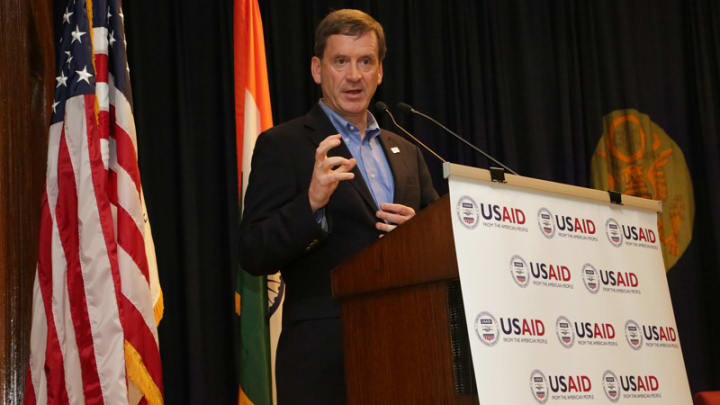
WASHINGTON — U.S. Agency for International Development leaders are poised to undertake one of the most significant restructuring efforts in the institution’s history.
A new organizational chart calls for the creation of new, high-level positions, the consolidation of a number of agency offices and functions, and a more unified approach to budgeting and management inside the world’s largest bilateral aid donor.
Administrator Mark Green revealed the proposed structure in a series of staff meetings and internal announcements last week. The agency will now present it to Congress and gather feedback from employees, implementing partners, and other U.S. aid experts.
“To be clear, our redesign has never been about the budget or a response to a budget. It's never been about staff size. It's never been about responding to a crisis or cause. It's been about pulling together the best ideas that we can find, some of them new, some of them not so new,” Green told staff at Thursday’s meeting in Washington, according to a transcript Devex obtained.
Among the most significant proposals is the realignment of USAID’s humanitarian, crisis, and conflict-related work under a new associate administrator for relief, resilience, and response, who would oversee the work of three different bureaus. One of those would be a new Bureau of Humanitarian Assistance, which would combine the offices of Food for Peace and U.S. Foreign Disaster Assistance.
“By eliminating the artificial bifurcation of food and non-food assistance at USAID, we will strengthen our coordination and become more effective and impactful,” said Jim Richardson, coordinator of USAID’s Transformation Task Team.
Two former directors of these offices, Dina Esposito and Jeremy Konyndyk, expressed support for this proposal — which Richardson called “the worst kept secret in Washington” — as long as it is not used as an excuse to slash USAID’s overall humanitarian assistance budget.
The new associate administrator would also oversee a Bureau for Resilience and Food Security, which combines USAID’s food security work with programs focused on water and climate change adaptation. A third Bureau for Conflict Prevention and Stabilization would gather together USAID’s programs for conflict-affected states, including the Office of Transition Initiatives and the agency’s work on countering violent extremism.
“The creation of this new role will provide the agency with a senior manager to track directly and respond to the intense day-to-day volume of crisis-related work in which the agency must respond,” Richardson said.
In what Richardson called “one of our most innovative changes,” agency leaders are proposing to create a new Bureau for Development, Democracy, and Innovation, which will combine existing units that provide technical and program design support into a “one-stop shop” of demand-driven consultancies that USAID missions can tap into.
The new bureau would absorb USAID’s Global Development Lab — created by former USAID administrator Rajiv Shah — as well as parts of the Bureau for Economic Growth, Education, and Environment, and a collection of “centers of excellence,” including the Center of Excellence on Democracy, Human Rights, and Governance. Their contributions will be tracked by new “customer service metrics,” aimed at measuring whether missions and bureaus have access to the right expertise at the right time, Richardson said.
“By bringing together experts, we believe that we’ll be able to better integrate innovation through the integration of our Global Development Lab, private enterprise, and good governance, all along with the long-term development efforts, designing programs with technology, private sector engagement, and diversity of partners in mind,” he said.
The new bureau will oversee USAID’s work on democracy, rights, and governance, and USAID’s leadership team hopes it will ensure that good governance and the protection of marginalized communities — along with technological innovation and private sector partnerships — are factored into program design and implementation from the outset.
No ‘outside consultants’
A third major change seeks to address what Richardson called “one of the largest employee pain points” identified during a “listening tour” his team conducted last summer: “a disconnect between policy and budget.” A new Bureau of Policy Resources and Performance would combine the scattered units that oversee USAID’s resource allocation with the various bodies that set policy and measure the agency’s performance.
The new bureau would also coordinate the use of USAID’s new “self-reliance metrics,” which are indicators currently in development to measure countries’ progress toward transitioning away from the need for U.S. foreign assistance.
“Importantly, this would strengthen our USAID posture interagency and with external stakeholders,” Richardson said, adding that the bureau would also “create a strong and unified interlocker” with the State Department’s “F Bureau,” a unit created in 2006 that oversees foreign affairs spending.
The new chart includes other changes, including the reintegration of the Office of Afghanistan and Pakistan Affairs into USAID’s Asia Bureau, which Richardson described as, “part of a larger transformation designed to align USAID structure to fulfill the national security strategy, the administration's Indo-Pacific approach, longer term development priorities in South and Central Asia, and strengthen USAID's ability to respond to crisis, particularly on a multi-country or pan-Asian regional basis.”
The transformation team is also considering — at the request of the White House Office of Management and Budget — how to consolidate security, human capital, and talent management under a new associate administrator for operations.
“By having a single point of accountability for management, budget, policy, human capital, and security, we will be able to improve the agency’s ability to quickly execute on the administrator’s decisions and agency priorities,” Richardson said.
Both Green and Richardson lauded the employee-led nature of this reorganization process, drawing an unspoken, but unmistakable contrast with the process undertaken at the State Department, where former Secretary of State Rex Tillerson reportedly spent $12 million on outside consultants who ultimately produced a significantly scaled-down redesign plan that the next secretary may or may not choose to ever implement.
“Instead of relying on outside consultants, we've harnessed the talent and the experience that we have right here inside the agency,” Green said.
“When the administrator asked us to take this on, we didn't turn to consultants from New York or Washington. We turned to you, and the results have been amazing,” Richardson echoed.
While the new organizational chart offers a tangible, unified proposal that USAID’s leadership can now distribute for feedback, the structural changes it proposes only amount to about 20 percent of the overall transformation Green and his team seek to bring about, the administrator said. The majority of USAID’s redesign will relate to process changes, which the agency is still developing and rolling out.
“How we do things, how we manage information points, how we harness our talent here at USAID — that's the 80 percent that will make all the difference,” Green said.




